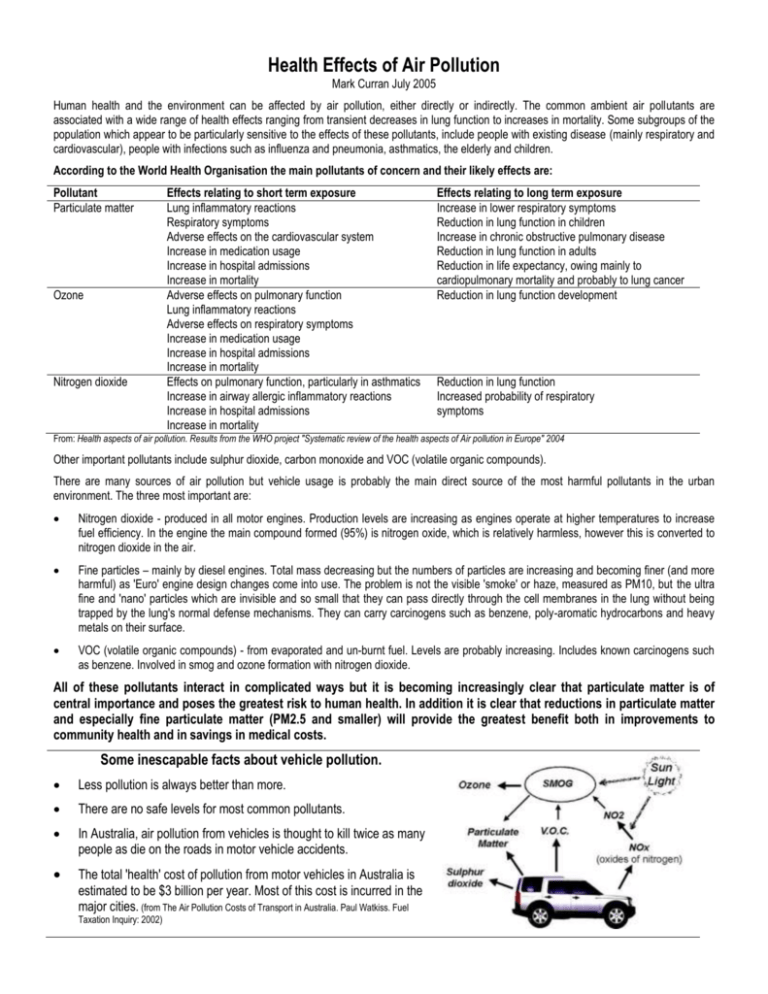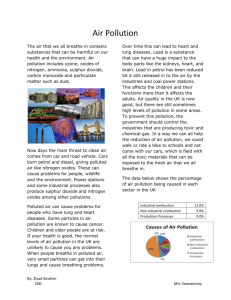The main air pollutants of concern are:
advertisement

Health Effects of Air Pollution Mark Curran July 2005 Human health and the environment can be affected by air pollution, either directly or indirectly. The common ambient air pollutants are associated with a wide range of health effects ranging from transient decreases in lung function to increases in mortality. Some subgroups of the population which appear to be particularly sensitive to the effects of these pollutants, include people with existing disease (mainly respiratory and cardiovascular), people with infections such as influenza and pneumonia, asthmatics, the elderly and children. According to the World Health Organisation the main pollutants of concern and their likely effects are: Pollutant Particulate matter Ozone Nitrogen dioxide Effects relating to short term exposure Lung inflammatory reactions Respiratory symptoms Adverse effects on the cardiovascular system Increase in medication usage Increase in hospital admissions Increase in mortality Adverse effects on pulmonary function Lung inflammatory reactions Adverse effects on respiratory symptoms Increase in medication usage Increase in hospital admissions Increase in mortality Effects on pulmonary function, particularly in asthmatics Increase in airway allergic inflammatory reactions Increase in hospital admissions Increase in mortality Effects relating to long term exposure Increase in lower respiratory symptoms Reduction in lung function in children Increase in chronic obstructive pulmonary disease Reduction in lung function in adults Reduction in life expectancy, owing mainly to cardiopulmonary mortality and probably to lung cancer Reduction in lung function development Reduction in lung function Increased probability of respiratory symptoms From: Health aspects of air pollution. Results from the WHO project "Systematic review of the health aspects of Air pollution in Europe" 2004 Other important pollutants include sulphur dioxide, carbon monoxide and VOC (volatile organic compounds). There are many sources of air pollution but vehicle usage is probably the main direct source of the most harmful pollutants in the urban environment. The three most important are: Nitrogen dioxide - produced in all motor engines. Production levels are increasing as engines operate at higher temperatures to increase fuel efficiency. In the engine the main compound formed (95%) is nitrogen oxide, which is relatively harmless, however this is converted to nitrogen dioxide in the air. Fine particles – mainly by diesel engines. Total mass decreasing but the numbers of particles are increasing and becoming finer (and more harmful) as 'Euro' engine design changes come into use. The problem is not the visible 'smoke' or haze, measured as PM10, but the ultra fine and 'nano' particles which are invisible and so small that they can pass directly through the cell membranes in the lung without being trapped by the lung's normal defense mechanisms. They can carry carcinogens such as benzene, poly-aromatic hydrocarbons and heavy metals on their surface. VOC (volatile organic compounds) - from evaporated and un-burnt fuel. Levels are probably increasing. Includes known carcinogens such as benzene. Involved in smog and ozone formation with nitrogen dioxide. All of these pollutants interact in complicated ways but it is becoming increasingly clear that particulate matter is of central importance and poses the greatest risk to human health. In addition it is clear that reductions in particulate matter and especially fine particulate matter (PM2.5 and smaller) will provide the greatest benefit both in improvements to community health and in savings in medical costs. Some inescapable facts about vehicle pollution. Less pollution is always better than more. There are no safe levels for most common pollutants. In Australia, air pollution from vehicles is thought to kill twice as many people as die on the roads in motor vehicle accidents. The total 'health' cost of pollution from motor vehicles in Australia is estimated to be $3 billion per year. Most of this cost is incurred in the major cities. (from The Air Pollution Costs of Transport in Australia. Paul Watkiss. Fuel Taxation Inquiry: 2002) Risks to children Children are thought to be at higher risk of suffering adverse effects of air pollution owing to their potentially high susceptibility. Important factors determining the susceptibility of children are: Factors related to physiology Children breathe more per unit body weight than adults Children have smaller airways and lungs Factors related to metabolism Different rate of toxification and detoxification Factors related to lung growth and development Vulnerability of developing and growing airways and alveoli. Immature host defence mechanisms Factors related to time-activity patterns Time spent outdoors. Increased ventilation with play and exercise Factors related to chronic disease High prevalence of asthma and other diseases Factors related to acute disease High rates of acute respiratory infections Adapted from: Health aspects of air pollution. Results from the WHO project "Systematic review of the health aspects of Air pollution in Europe" 2004 Real costs of air pollution In a detailed study of the real costs of air pollution in Tokyo, it is estimated that the overall benefit of the very significant reduction in particulate pollution (PM10) which had been achieved in that city, from >100µg/m 3 in 1975 to <45µg/m3 in 1998, had provided a total benefit in 1999 of over $A47 billion, including the cost of lost wages. Benefits Analysis of Particulate Matter Control Programs – A Case Study in Tokyo A.S. Voorhees - J. Risk Research Vol. 8, 311-329 (June, 2005) Motorways and Tunnels. Although the construction of a new motorway may lead to significant improvements in traffic flow and initial reductions in vehicle pollution, it will inevitably lead to a change in the way in which vehicle pollution is distributed. One of the main benefits claimed to result from the construction of new motorways is the reduction in total pollution due to the speeding up of traffic. The actual results are shown here. These improvements are quickly lost if traffic grows as a result of the new motorway. Traffic on the M5 has increased over 40% since opening and is now at levels predicted to be reached in 2020. Speed NOx (g/km) NOx (g/km) EURO1 Particulate EURO1 Petrol Car 10t truck 10t truck 20 km/hr 100% 100% 100% 40 km/hr 100% 89% 60% 60 km/hr 88% 78% 47% 80 km/hr 92% 76% 43% Adapted from PIARC: Road Tunnels: Emissions ,Ventilation, Environment. 1995. Some will benefit from these changes but some will suffer from them. Inevitably, it is difficult to predict those who will suffer by the changes and by how much. Major surface motorways show clear pollution impacts covering at least 100 to 200 meters on both sides of the road and possibly further. These new impacts affect both the health of people living and working in these areas and the values of nearby residential properties. Tunnels Tunnels are a useful way of removing or significantly changing the impacts of motorways. Those living above the line of the tunnel have nothing to fear except, possibly, for some transient noise and vibration during construction. Besides being massively expensive to construct and operate, the real problem with tunnels results from their capacity to concentrate vehicle emissions far above the levels found on surface roads. This provides a problem for both users and those living near the tunnel ends (portals) and in locations where they can be impacted by emissions from ventilation stacks. Travellers in Sydney tunnels are regularly exposed to pollutant levels, especially of particulate matter, 10 to 20 times that experienced on open city motorways. Taking into account the reduced trip times which result from motorway use, pollutant exposure per trip is increased about 5 fold by a trip through one of Sydney's busier tunnels. Additional particle exposure due to two peak hour 'commuter' trips in the M5 tunnel can increase a motorist's daily exposure by almost 50%. The Lane Cove tunnel air quality consent conditions would permit the pollution levels currently experienced in the M5 tunnel. Residents living close to the M5 stack at Turrella have regularly reported significant odour annoyance and ill-effects such as sore eyes, throat irritation and increased asthma since the tunnel opened. The study carried out by NSW Health into these reports was inconclusive and unreliable due to significant flaws both in the study design and the statistical analysis. Many residents most exposed to the stack emissions, have been forced to sell their houses because of repeated family illness. In doing so some have suffered significant financial loss, which was uncompensated in any way. Tunnel Filtration Effective electrostatic precipitator filtration technologies are in use in Japan, Norway, South Korea and Vietnam to remove particulate matter both from inside tunnels and from ventilation stacks. Modern practice removes the particulate matter inside the tunnel, close to the point of formation. Both Japan and Norway, the main users, report that the constructive use of filtration can significantly reduce the overall cost of running tunnel ventilation systems, without factoring in reduced health costs. Madrid city has just announced it will filter the ventilation exhausts from the 55 km of tunnels in the new Calle 30 ring route to improve local air quality. Equipment for removal of nitrogen dioxide is under development but the need and economic viability of the use of such equipment in a city such as Sydney is difficult to justify except in a few special cases.







